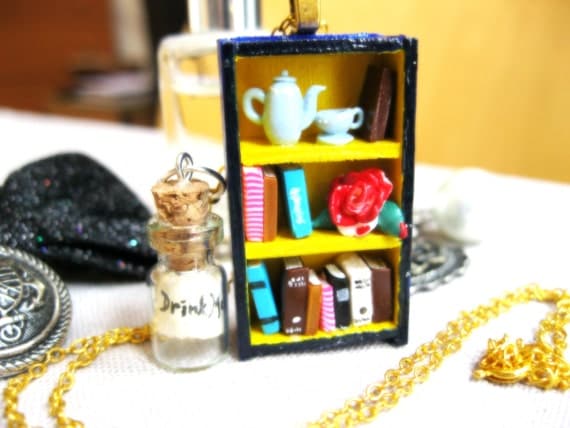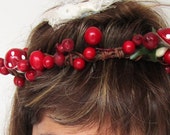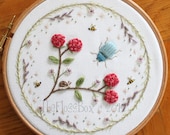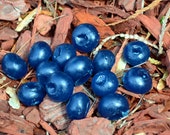Saturday, 13 April 2013
Wednesday, 10 April 2013
My Craft Apron
 I love my craft Apron... I bought it at a craft fair with my crafty earnings a few months ago, and whenever I wear it it puts me in the crafty zone!
I love my craft Apron... I bought it at a craft fair with my crafty earnings a few months ago, and whenever I wear it it puts me in the crafty zone!It's sweet and polkadotted, has big pockets, and gives me something else to wipe my varnish-y and paint-y hands on so I don't keep ruining my trousers.
Plus, and I know it sounds strange, but it's actually quite warm... it's just a nice thick cotton material, but in my chilly house in chilly England during this chilly winter (yes it's still winter in England, it's been lasting FOREVER), layers are a must.
And it's a bonus if those layers are cute polkadots that make you feel creative and artsy.
Sunday, 7 April 2013
New Regular Items - Stack of Books Earrings and Penguin Book Stud Earrings
My Stack of Books Earrings and Penguin Book Stud Earrings have always been popular numbers on my Etsy site, so I've made them Made to Order items so they can be bought at any time! Instead of waiting until I have time to make 4 or 5 and take new pictures and put them up now and again, which isn't very consistently!
So any time you want, you can be the owner of these sweet earrings:
So any time you want, you can be the owner of these sweet earrings:
Thursday, 4 April 2013
Varnishing Polymer Clay
 Varnishing your polymer clay items is really important for making your items last and look their best. Unvarnished pieces can scratch and pieces can break off really easily, and some polymer clays stay quite soft after they have been baked.
Varnishing your polymer clay items is really important for making your items last and look their best. Unvarnished pieces can scratch and pieces can break off really easily, and some polymer clays stay quite soft after they have been baked.So which varnish is the best to use?
When I first started out making items with polymer clay I used a bit of an unorthadox method, and finished my pieces with clear nail polish - it makes a really hard finish and it your pieces are small like mine, it keeps little bits from chipping of since it acts like a really strong glue.
 Unfortunately this hold doesn't last - it also yellows a bit after a year, and starts to go a bit sticky. Pieces get a bit gummy and break off. So I abandoned the nail polish for the purpose made stuff, Fimo's Gloss Varnish.
Unfortunately this hold doesn't last - it also yellows a bit after a year, and starts to go a bit sticky. Pieces get a bit gummy and break off. So I abandoned the nail polish for the purpose made stuff, Fimo's Gloss Varnish. This varnish is fantastic - its best feature is it's a really thin liquid, but still makes an extremely hard shiny shell over your piece that protects is really well. Two layers of this will make your items really last. I haven't noticed any yellowing or peeling, either.
One drawback is that it is a slightly whitish opaque colour, and if some pools in a little crack, you can be left with a whitish mark where it dries. To avoid this, use the paintbrush in a dabbing motion and only apply a thin layer at a time.
Since it worked so well, but is a bit pricey, I tried out another polyeurethane varnish from ebay a while ago. Unfortunately it just didn't cut it. It was by Craftmill and quite a lot cheaper, so I thought I'd give it a go. It ended up, when in contact with glue, turning crystaline and crumbling off. It also had a tendency to yellow a bit. I stopped using it immediately after a bunch of my teapot earrings broke in transit to a shop where I sell some of my items :( Into the bin it went!
 Another popular polymer clay varnish is by Sculpey, who make Sculpey polymer clay as well as Premo, which is my favourite. I haven't tried it myself, but it will be my next to experiement with. I've heard it can be a bit goopy and peely, and that it has the yellowing problem, but I can't judge as I have yet to try it. I also imagine that it will be slightly cheaper than Fimo, as most things are!
Another popular polymer clay varnish is by Sculpey, who make Sculpey polymer clay as well as Premo, which is my favourite. I haven't tried it myself, but it will be my next to experiement with. I've heard it can be a bit goopy and peely, and that it has the yellowing problem, but I can't judge as I have yet to try it. I also imagine that it will be slightly cheaper than Fimo, as most things are! There are lots of alternatives for polymer clay finishes, from floor polishes to wood varnishes, to paint varnishes that are common in craft stores, and there seem to be varying results in a lot of them.
There are lots of alternatives for polymer clay finishes, from floor polishes to wood varnishes, to paint varnishes that are common in craft stores, and there seem to be varying results in a lot of them. Personally I'm going to stick to the purpose made ones, as I want to play it safe with jewellery that I'm selling. It's hard to know how a varnish will hold up a year from working with it, and since I know Fimo works well, that is that one I will probably always stick with. It's hardness always impresses me, and it may be a bit pricey, but the confidence I have in it is worth that price!
Sunday, 31 March 2013
Book Review: The Thousand Autumns of Jacob De Zoet by David Mitchell
I picked this book up at Blackwells in Oxford last month when I was craving some more fiction in my life. I have a bad habit of neglecting fiction because I feel guilty spending my time reading if I'm not contributing to some sort of knowledge growth for some reason. Too much student-ing I guess.
But the front cover of The Thousand Autumns of Jacob de Zoet caught my eye as I'm interested in Japanese culture (I've studied Japanese since my teen years and have been to Japan a couple times), and I recognise David Mitchell's name but have never read The Cloud Atlas or any other of his books before. I have to say I really enjoyed it, but my feelings about this book is about as complex as his list of characters!
The book takes place at the end of the 18th and beginning of the 19th centuries, on Dejima, a Dutch trading post on an artificial island off Nagasaki. It follows a number of characters, namely Jacob de Zoet, a young pious Dutchman working with the trading company to prove and make a name for himself so that when he returns home he can be accepted by his love's family and win her hand. However, on Dejima he falls in love with a young medical student, a Japanese midwife with a scarred face named Aibagawa Orito.
The story is rich and further in becomes truly epic, which I didn't at first expect. What I was most suprised about was the sheer number of characters in the story. It is written from the point of view of a number of them as the story transitions, as well. I stuggled to keep track of who was who, and gave up a few times - there are character lists at the back, which indicates how truly numerous they are.
This story contained cultural elements from historical Japan, Holland, and Britain, and for that reason it added another dimension of 'cognitive skill' to get through as well. The characters' language is rich with references to items and concepts that are foreign both in time and space, and it was sometimes a bit frustrating to read on knowing that you weren't completely understanding the richness the author obviously knew more about through his obviously extensive research. Mitchell had lived in Japan when he was young, and very skillfully takes you to 18th century Japan, with sights, smells, images - but doesn't slow much to explain them all. My Japanese was good enough to understand phrases used in the book, but I still felt a bit lost in certain circumstances when you just had to accept that there was some richer meaning that a 17th century Japanese, or Dutch, person would have understood much better.
My biggest criticism of the book is related to this - Mitchell introduces characters to the story at an alarming rate, and often all at once, whose names are difficult to pronounce and hard to remember. While it makes for realistic and believable situations, the reader (or I, anyways) became frustrated at the lack of hand-holding to point to who was saying what. Often speech was said and not marked - and when five or so new characters are talking, my brain just couldn't handle who was who - the frustration becoming heightened, when all of those characters in turn became important to the story in some way or another.
But the plot was truly epic, and enjoyable. The characters were dynamic and believable, and interesting. The imagery was great as well, and Mitchell illustrated his story in my mind beautifully. It was a long and complex book, but a fantastic ride. And even though it was fiction, I was learning about 18th century botany, medicine, and international trade and politics at the same time!
I'd rate this book 4 out of 5 stars - thoroughly enjoyable but definitely not an 'easy read'!





But the front cover of The Thousand Autumns of Jacob de Zoet caught my eye as I'm interested in Japanese culture (I've studied Japanese since my teen years and have been to Japan a couple times), and I recognise David Mitchell's name but have never read The Cloud Atlas or any other of his books before. I have to say I really enjoyed it, but my feelings about this book is about as complex as his list of characters!
The book takes place at the end of the 18th and beginning of the 19th centuries, on Dejima, a Dutch trading post on an artificial island off Nagasaki. It follows a number of characters, namely Jacob de Zoet, a young pious Dutchman working with the trading company to prove and make a name for himself so that when he returns home he can be accepted by his love's family and win her hand. However, on Dejima he falls in love with a young medical student, a Japanese midwife with a scarred face named Aibagawa Orito.
 |
| A map of Dejima, the 17th century artificial island built by merchants |
This story contained cultural elements from historical Japan, Holland, and Britain, and for that reason it added another dimension of 'cognitive skill' to get through as well. The characters' language is rich with references to items and concepts that are foreign both in time and space, and it was sometimes a bit frustrating to read on knowing that you weren't completely understanding the richness the author obviously knew more about through his obviously extensive research. Mitchell had lived in Japan when he was young, and very skillfully takes you to 18th century Japan, with sights, smells, images - but doesn't slow much to explain them all. My Japanese was good enough to understand phrases used in the book, but I still felt a bit lost in certain circumstances when you just had to accept that there was some richer meaning that a 17th century Japanese, or Dutch, person would have understood much better.
My biggest criticism of the book is related to this - Mitchell introduces characters to the story at an alarming rate, and often all at once, whose names are difficult to pronounce and hard to remember. While it makes for realistic and believable situations, the reader (or I, anyways) became frustrated at the lack of hand-holding to point to who was saying what. Often speech was said and not marked - and when five or so new characters are talking, my brain just couldn't handle who was who - the frustration becoming heightened, when all of those characters in turn became important to the story in some way or another.
 |
| Dejima is a real, and you can visit it if you're ever in the Nagasaki area! |
But the plot was truly epic, and enjoyable. The characters were dynamic and believable, and interesting. The imagery was great as well, and Mitchell illustrated his story in my mind beautifully. It was a long and complex book, but a fantastic ride. And even though it was fiction, I was learning about 18th century botany, medicine, and international trade and politics at the same time!
I'd rate this book 4 out of 5 stars - thoroughly enjoyable but definitely not an 'easy read'!





Saturday, 30 March 2013
March Giveaway Winner
Hooray! It's time to announce the winner of my March giveaway for an Alice in Wonderland Bookshelf Necklace!
*drumroll* ...and the winner is...
*drumroll* ...and the winner is...
*********Sydney D.!*********
Congratulations! I'll be getting in touch with you soon to let you know you've won!
Monday, 25 March 2013
Berries
Yes, I'm blogging about berries. I love berries. Sweet juicy fruit, magically growing on a bush for our picking pleasure, to put in pancakes or muffins or pies. It's the best thing!
I was partly inspired by my love of berries to make these little blackberry earrings, made from polymer clay:
The varnish gives it a nice shine and makes me want to go by tartlet cups and whipping cream!
An old childhood favourite berry was, however, this little darling:
I was partly inspired by my love of berries to make these little blackberry earrings, made from polymer clay:
 |
| Blackberry Earrings by Coryographies |
The varnish gives it a nice shine and makes me want to go by tartlet cups and whipping cream!
An old childhood favourite berry was, however, this little darling:
This is the mighty huckleberry, which I loved to graze on when outdoors, and bring in a little margarine container full for Sunday pancakes. I thought they might make some cute earrings if I can capture their charm.
In a tribute to berries, I've made an Etsy treasury. See if there's something you like. Enjoy!
Saturday, 23 March 2013
Sunday, 17 March 2013
Giveaway and New Bookshelf Necklace: Alice in Wonderland Bookshelf Necklace
It's time for my next giveaway! This month I will be giving away my brand new Alice in Wonderland Bookshelf Necklace:
It features a light blue tea set on the top shelf, and a white rose (painted red) on the second. There is also a little bottle charm attached to the necklace that says 'Drink Me'! It is strung on an 18" gold chain.
For more pictures you can see it on my Etsy page here: https://www.etsy.com/listing/126678986/alice-in-wonderland-bookshelf-necklace?
Enter through Rafflecopter here:
a Rafflecopter giveaway
The contest closes on March 30th, and the winner will be announced on March 31st! Good luck!
It features a light blue tea set on the top shelf, and a white rose (painted red) on the second. There is also a little bottle charm attached to the necklace that says 'Drink Me'! It is strung on an 18" gold chain.
For more pictures you can see it on my Etsy page here: https://www.etsy.com/listing/126678986/alice-in-wonderland-bookshelf-necklace?
Enter through Rafflecopter here:
a Rafflecopter giveaway
The contest closes on March 30th, and the winner will be announced on March 31st! Good luck!
Saturday, 9 March 2013
March updates and February roundup
 |
| Hey girl, Cory's a bit busy at the moment, but she'll get that next giveaway up and running real soon... |
So what has happened, right, is I went and got another temporary job. March - July tend to be pretty dry in the sales. And by 'tend to' I mean that's the way it was last year! This is only year 2 of Coryographies after all...
So I got another temporary job to supplement the ol' income while no one buys bookshelf necklaces over the Spring/Summer. I'm also saving up for that possible PhD that I applied for, and am awaiting new on that - but until then I need to be busy at both jobs. Which means I'm a bit less bloggy again.
But I'll keep trying! There's a new necklace to unveil after all, that is sitting on my kitchen table as wel speak... just need to take a few pics and upload them so I can organise the giveaway too.
Also, I haven't done my February round up of books on my supposed goal of reading 150 books in 2013. I'll be honest here, there's no way I'll make this goal. But hey, reach for the stars and land on the moon, it's all good. Here's what I can add for February's reading though:
-The Origins of Grammar: Evidence from Early Language Comprehension by Kathy Hirsh-Pasek and Roberta Michnick Golinkoff
-The Seamstress by Maria Duenas
Doesn't sound like much? It's not. But I have read a bunch of papers which I can add to the list which I told myself I can make count...
In other news, my husband has just informed me that there is a place in England called "Bapchild". Nice.
Subscribe to:
Posts (Atom)






















